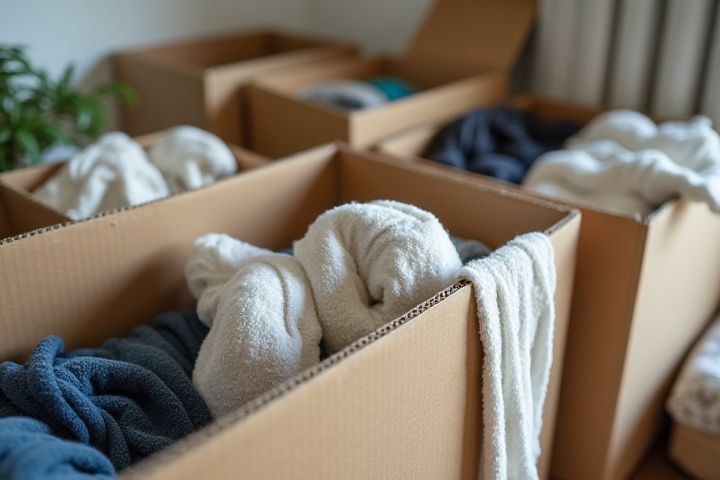
Begin by categorizing your belongings into three groups: keep, donate, and discard. Focus on one room at a time to avoid feeling overwhelmed, ensuring each space is thoroughly evaluated. Use clear storage bins to organize items you intend to keep, allowing easy access and visibility in your new home. As you sort through items, consider popular donation centers or local charities that accept household goods, making a positive impact while decluttering. Remember, a minimalist approach not only eases the moving process but also sets the foundation for a more organized living space in your next home.
How To Declutter A House For Moving
Plan and prioritize areas.
Begin by assessing your home and identifying key areas that require decluttering, such as bedrooms, kitchens, and living rooms. Create a prioritization list, focusing on spaces that are most frequently used or need immediate attention. Allocate specific timelines for each area to maintain momentum and organization throughout the process. By systematically tackling one section at a time, you can efficiently reduce clutter and facilitate a smoother transition to your new home.
Sort items systematically.
Begin by categorizing your belongings into distinct groups such as keep, donate, sell, and discard. Use boxes to sort items systematically, labeling each box clearly to minimize confusion during packing. As you evaluate each item, consider its functionality, emotional value, and whether it aligns with your future living space. To create a more efficient process, tackle one room at a time, ensuring you stay organized and motivated throughout your decluttering journey.
Use the "keep, donate, discard" method.
Start by categorizing your belongings into three groups: "keep," "donate," and "discard." For the "keep" category, only select items you truly need or have significant sentimental value, aiming for fewer than 30% of your total possessions. Items in the "donate" bin should be in good condition, allowing you to help others while also reducing your workload; consider local charities or shelters. Finally, the "discard" pile should contain anything damaged or unusable, and promptly arrange for its removal to prevent clutter from creeping back into your space.
Set decluttering goals.
Setting decluttering goals is essential when preparing to move, as it helps streamline the process and reduces stress. Start by breaking down your home into specific areas, such as rooms or categories like clothing, kitchenware, and decor. Assign realistic timelines for each area, and aim to tackle one space at a time, which makes the task less overwhelming. Keep in mind your new living space's dimensions and needs, ensuring you only take items that truly serve a purpose or hold significant value.
Use labeling for organization.
Using labeling for organization is essential when decluttering your house for a move. Clearly marked boxes help you quickly identify the contents, saving you time and effort during the packing process. You can categorize items by room or type, such as "Kitchen," "Living Room," or "Winter Clothes," making unpacking in your new home more efficient. Invest in durable labels or a labeling machine to maintain consistency and ensure everything is easily identifiable.
Limit sentimental item retention.
Begin by identifying sentimental items that hold significant emotional value versus those that merely occupy space. Consider using a 'keep, donate, or discard' method to streamline your decision-making process, limiting the number of sentimental items you retain. You can also take photographs of cherished items you are unwilling to keep in order to preserve memories without the physical clutter. This approach allows you to focus on essentials, making your move more organized while keeping meaningful memories intact.
Evaluate duplicates.
Evaluating duplicates is essential when decluttering your house for a move, as it helps streamline your belongings and reduce unnecessary weight. Start by assessing each room, particularly areas like kitchens and wardrobes, where similar items often accumulate, such as multiple sets of cookware or an overabundance of clothing. You can categorize these items by function and condition, deciding which duplicates are truly functional and which can be donated or discarded. This process not only lightens your load but also makes unpacking easier in your new space, allowing you to enjoy a fresh start without unnecessary clutter.
Schedule regular declutter sessions.
To effectively declutter your home before moving, schedule regular decluttering sessions, ideally bi-weekly or monthly. Set aside a specific day and time, dedicating at least two hours to focus on each room, systematically sorting items into "keep," "donate," and "discard" categories. Use a timer to maintain focus and avoid distractions, making the process more manageable and less overwhelming. Finally, consider applying a decluttering method, like the Marie Kondo approach, to ensure you keep only items that spark joy and serve a purpose in your new space.
Consider space in new home.
When decluttering for a move, assess the available space in your new home to determine what items are truly necessary. Start by measuring rooms and closets to understand their dimensions and capacities, allowing you to prioritize what furniture and belongings will fit. Categorize your possessions into keep, donate, or discard, focusing on items that serve a purpose or evoke positive memories. Remember, this process not only streamlines your packing but also creates a more organized and functional living space in your new home.
Use storage solutions efficiently.
Utilizing efficient storage solutions is crucial for decluttering your house before a move. Consider high-quality, stackable bins that maximize vertical space, allowing you to store items like seasonal clothing, books, and decor neatly. Invest in vacuum-seal bags for soft items, which can reduce their volume by up to 75%, making packing and transporting easier. Don't forget to label each container clearly; this will streamline unpacking and ensure you find what you need quickly at your new home.
